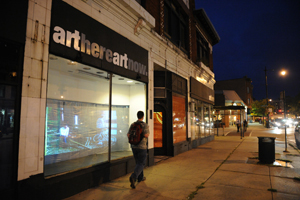Storefront galleries
Art Here Art Now makes vacant space vibrant in Hyde Park.
By Burke Frank, ’11
Photography by Dan Dry

Art Here Art Now exhibitions brightened four empty storefronts on 53rd Street.
Although no businesses occupy the storefronts between Harper and Blackstone Avenues, a different kind of activity lined the north side of 53rd Street in October. Video installations, a studio space crowded with paint and plaster, and a meticulously preserved barbershop filled the retail void. The exhibitions lit up 53rd Street as part of Art Here Art Now, a collaboration between the University’s Office of Community Engagement and the Hyde Park Alliance for Arts and Culture.
“The idea was to present the artist’s studio in a public forum,” says Dara Epison, program coordinator for University and community-arts collaborations. “It’s about presenting the craft of the artist in a public way and making it as accessible as possible.”
Using vacant storefronts as exhibition spaces isn’t new in Chicago. Epison cites other projects around the city, like last year’s Pop-Up Art downtown and similar attractions in Wicker Park, as inspirations for Art Here Art Now.
For his installation, Andre Callot, MFA’08, who edits video for a New York advertising firm, used footage he’d shot during a fall 2007 class project but never used. Holidays shows a series of loosely connected scenes in different weather conditions—fall leaves, snow, and spring-like thaw—in upstate New York. Because of the storefront venue, Callot cut out the dialogue and turned the footage into a silent film. “That way it didn’t matter if it didn’t make sense according to the original story because I can build a new story from scratch,” he says. “It’s not a linear story.”
The film’s three characters, two young men and one female of intentionally ambiguous gender, share disconnected scenes in fields and on a farm. In one scene, two of the characters dance intimately; Callot says he found the scene compelling because it suggests homoeroticism even though the two characters are of different sexes. “What was interesting to me was creating a love triangle where you don’t know which parts of it are supposed to be homoerotic,” he says. Callot was pleased that the installation helped bring life to 53rd Street. “For two years I lived a block away from those storefronts, and I was always shocked that there was so little development in this wonderful neighborhood.”
Harper Theater, the vacant building that houses the storefronts, was built in 1913 for vaudeville performances. Concerns about potential demolition and future development led Landmarks Illinois, a nonprofit preservation organization, to add the theater to its 2008–09 watch list of endangered properties. Epison says Art Here Art Now drew attention to the space, and she hopes that it can spur continued use.
“Just by virtue of being present on 53rd Street, we’ve had a number of people inquire as to what’s going to happen and ask, ‘How can I get involved?’” Epison says. “Ideally we can make a case for not leaving these spaces empty. This is only a temporary solution, but it draws attention to the fact that this beautiful building has been sitting empty for way too long.”
Art Here Art Now, part of the City of Chicago Department of Cultural Affairs’ Chicago Artists Month, also included a studio space at the corner of Harper and 53rd Street. Open Saturday afternoons to the public, local artists Marty Burns, Cydney Lewis, and Melissa Weber created their sculptures in full view.
Keeping the public engaged with these empty buildings can have positive social and economic benefits, Epison says, and the experiment aims to bring community members, businesses looking to expand in Hyde Park, and the University to the space.
“Ultimately we’re hoping to start a conversation,” Epison says, “to make an argument for why this is important, and hopefully that argument will be heard.”
Return to top
